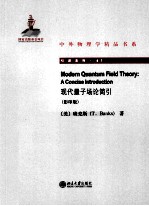

现代量子场论简引=MODERN QUANTUM FIELD THEORY:A CONCISE INTRODUCTION 影印版 英文PDF电子书下载
- 电子书积分:20 积分如何计算积分?
- 作 者:李发锁著
- 出 版 社:
- 出版年份:2014
- ISBN:
- 页数:0 页
1 Introduction 1
1.1 Preface and conventions 1
1.2 Why quantum field theory? 3
2 Quantum theory of free scalar fields 8
2.1 Localfields 10
2.2 Problems for Chapter 2 13
3 Interacting field theory 17
3.1 Schwinger-Dyson equations and functional integrals 17
3.2 Functional integral solution of the SD equations 20
3.3 Perturbation theory 24
3.4 Connected and 1-P(article)I(rreducible)Green functions 26
3.5 Legendre's trees 28
3.6 The K?llen-Lehmann spectral representation 30
3.7 The scattering matrix and the LSZ formula 32
3.8 Problems for Chapter 3 36
4 Particles of spin 1,and gauge invariance 38
4.1 Massive spinning particles 38
4.2 Massless particles with helicity 39
4.3 Field theory for massive spin-1 particles 40
4.4 Problems for Chapter 4 43
5 Spin-1/2 particles and Fermi statistics 44
5.1 Dirac,Majorana,and Weyl fields:discrete symmetries 49
5.2 The functional formalism for fermion fields 56
5.3 Feynman rules for Dirac fermions 58
5.4 Problems for Chapter 5 59
6 Massive quantum electrodynamics 62
6.1 Free the longitudinal gauge bosons! 64
6.2 Heavy-fermion production in electron-positron annihilation 65
6.3 Interaction with heavy fermions:particle paths and external fields 68
6.4 The magnetic moment of a weakly coupled charged particle 69
6.5 Problems for Chapter 6 74
7 Symmetries,Ward identities,and Nambu-Goldstone bosons 76
7.1 Space-time symmetries 78
7.2 Spontaneously broken symmetries 81
7.3 Nambu-Goldstone bosons in the semi-classical expansion 84
7.4 Low-energy effective field theory of Nambu-Goldstone bosons 85
7.5 Problems for Chapter 7 89
8 Non-abelian gauge theory 93
8.1 The non-abelian Higgs phenomenon 96
8.2 BRST symmetry 97
8.3 A brief history of the physics of non-abelian gauge theory 99
8.4 The Higgs model,duality,and the phases of gauge theory 101
8.5 Confinement of monopoles in the Higgs phase 103
8.6 The electro-weak sector of the standard model 113
8.7 Symmetries and symmetry breaking in the strong interactions 116
8.8 Anomalies 118
8.9 Quantization of gauge theories in the Higgs phase 130
8.10 Problems for Chapter 8 132
9 Renormalization and effective field theory 137
9.1 Divergences in Feynman graphs 139
9.2 Cut-offs 142
9.3 Renormalization and critical phenomena 145
9.4 The renormalization(semi-)group in field theory 148
9.5 Mathematical(Lorentz-invariant,unitary)quantum field theory 154
9.6 Renormalization ofφ4 field theory 156
9.7 Renormalization-group equations in dimensional regularization 161
9.8 Renormalization of QED at one loop 164
9.9 Renormalization-group equations in QED 173
9.10 Why is QED IR-free? 178
9.11 Coupling renormalization in non-abelian gauge theory 181
9.12 Renormalization-group equations for masses and the hierarchy problem 188
9.13 Renormalization-group equations for the S-matrix 191
9.14 Renormalization and symmetry 193
9.15 The standard model through the lens of renormalization 201
9.16 Problems for Chapter 9 203
10 Instantons and solitons 206
10.1 The most probable escape path 206
10.2 Instantons in quantum mechanics 207
10.3 Instantons and solitons in field theory 213
10.4 Instantons in the two-dimensional Higgs model 216
10.5 Monopole instantons in three-dimensional Higgs models 221
10.6 Yang-Mills instantons 226
10.7 Solitons 232
10.8 't Hooft-Polyakov monopoles 236
10.9 Problems for Chapter 10 239
11 Concluding remarks 242
Appendix A Books 245
Appendix B Cross sections 247
Appendix C Diracology 248
Appendix D Feynman rules 251
Appendix E Group theory and Lie algebras 256
Appendix F Everything else 260
References 262
Author index 268
Subject index 269
- 《微笑 影印本》N.达列基作 1947
- 《量子系统的非平衡多体理论》(意)G.斯蒂芬尼茨,(德)R.冯·莱文 2019
- 《金丝髪 侦探小说 影印本》格离痕著 1914
- 《戊戌六君子遗集 影印本 上》谭嗣同撰 2019
- 《深入浅出Ruby 影印版》Jay McGavren 2017
- 《方程组实数解的几何方法 影印版》Frank Sottile 2018
- 《比较蛋白质组学的生物信息学 影印版》(美)C·H·Wu 2016
- 《异物志 中医经典古籍集成 影印本》(东汉)杨孚 2018
- 《仲景归真 中医经典古籍集成 影印本》(清)陈焕堂 2018
- 《量子力学基础》郑伟谋著 2019
